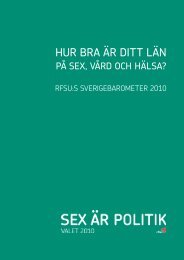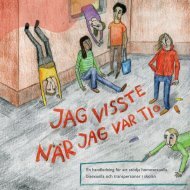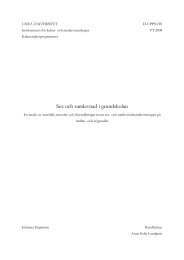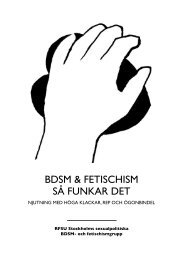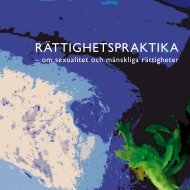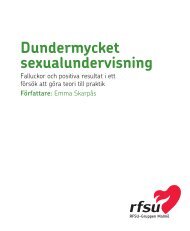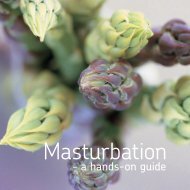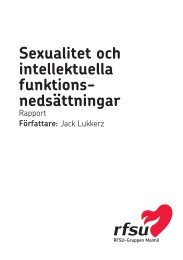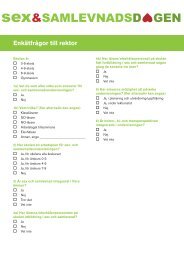Download pdf - RFSU
Download pdf - RFSU
Download pdf - RFSU
You also want an ePaper? Increase the reach of your titles
YUMPU automatically turns print PDFs into web optimized ePapers that Google loves.
gathering of information and reflections on the treatment<br />
method.<br />
The clinic decided to pay attention to this group of<br />
patients’ special difficulties and offer the possibility of<br />
psychotherapy within the clinic’s framework. The aim<br />
was to improve knowledge of the psychological forces<br />
driving men and women to buy or sell sex, and to find<br />
suitable methods for meeting, caring for and treating these<br />
individuals. The project commenced in January 2000.<br />
The Gender Equality Board of the Ministry of Industry,<br />
Employment and Communications and as well as the City<br />
of Stockholm’s Social Welfare Services has financed it.<br />
Some of the questions that we asked were:<br />
• What makes a woman, who could earn a living<br />
from normal work, become a prostitute?<br />
• What makes a man, who already has a sexual<br />
partner, become prepared to pay for sex with<br />
another woman?<br />
• What are the psychological driving forces that<br />
make it possible to turn intimacy into an economic<br />
transaction?<br />
• Why do people commit acts over and over again<br />
that they, at least partly, comprehend as being<br />
destructive?<br />
• Why is it so very difficult to create a solid and<br />
creative psychotherapeutic relationship with<br />
these people who seem to be in a real psychological<br />
emergency?<br />
• How can we develop our psychotherapeutic<br />
methods to meet and take care of this client<br />
group?<br />
This report is an attempt to answer these questions. It is<br />
based on clinical contacts with a total of 55 people during<br />
the years 1998-2003.<br />
Different perspectives on<br />
prostitution<br />
In Sweden, attempts have been made in recent decades<br />
to try to combat the sex trade with help from legislation<br />
and various social programmes. Two governmental<br />
analyses (SOU 1981:71 and SOU 1995:15) have been<br />
made since the late 1970´s. These analyses were aimed<br />
at providing support for political measures, as a result of<br />
this, prostitution was made a criminal offence in 1999.<br />
The question of criminalisation of prostitution has often<br />
been debated. The investigation of prostitution in 1977<br />
(SOU 1977:01) has, with its analysis of heterosexual<br />
prostitution, illuminated the relationship of prostitution<br />
to the buyer. This political activity has contributed to the<br />
increased knowledge, especially concerning the role of the<br />
social and cultural mechanisms, and has helped to better<br />
map the phenomenon.<br />
Prostitution from a sociological<br />
perspective<br />
According to the Swedish National Institute of Public<br />
Health´s latest completed survey on sexual habits “Sex in<br />
Sweden” (1998:11), about one in every eight men will, at<br />
some point in his life, buy sex. The majority of the men<br />
who buy sex are middle-aged, married or cohabiting, and<br />
have children. According to an <strong>RFSU</strong>-clinic survey (e.g.<br />
5



